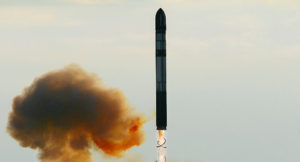
Sputnik:
On Monday, a defense industry official told Russian media that the mass production of the RS-28 Sarmat intercontinental ballistic missile, a new multi-warhead, super-heavy missile designed to defeat anti-missile systems, would begin in 2018, two years ahead of schedule. Defense analyst Vladimir Tuchkov explains what made this possible.The Sarmat, being developed by the Makeyev Rocket Design Bureau in the city of Miass, just east of the Ural Mountains, will replace the RS-36, a family of ICBMs and space launch vehicles that entered service in the 1970s and 1980s.
Featuring a large payload capacity, the heavy missile is expected to carry up to 10 heavy warheads, or 16 lighter ones, or a combination of warheads and countermeasures meant at overwhelming enemy missile defenses. Most concerning to foreign defense observers is the prospect of the Sarmat being armed with Project 4202, a hypersonic glider which, after separating from its ICBM launch vehicle, will be able to accelerate to speeds between Mach 7 and Mach 12, acting like a hypersonic cruise missile, and capable of maneuvering to overcome any existing or prospective missile defense to reach its target.
The Sarmat missile, whose development began in 2009, has been touted as Russia’s response to US projects including the Prompt Global Strike initiative, and as well the effort to deploy missile defense near Russia’s borders. If nothing else, Moscow hopes that the new missile and its payload will deter US efforts to gain strategic superiority over Moscow, or, in the worst case scenario, to launch a surprise attack on Russia.
Russia’s Strategic Missile Forces initially expected the arrival of the first parties of the new missile by 2020, in accordance with the state’s defense program to the year 2020. But on Monday, a source within the Russian military industrial complex told Russian media that “the first Sarmats will be introduced to the Strategic Missile Forces no later than 2019, and most likely – in 2018.”
Commenting on the news, Vladimir Tuchkov, military analyst and contributor to the independent online newspaper Svobodnaya Pressa, emphasized that the quickened pace of development was made possible by the modernization of the industrial base at the Krasnoyarsk Machine-Building Plant, where the production of the Sarmat missile is set to take place.
Thankfully, Tuchkov added, the modernization of the enterprise’s production capabilities came at a very timely moment, in view of the deterioration of relations between Russia and the NATO bloc, led by the United States. “The new missile will be a powerful deterrent, significantly outperforming all existing carriers of nuclear weapons,” the analyst noted.
At the same time, the analyst pointed out that at the moment, Russia’s silo-based, liquid fueled R-36M2, Voyevoda (NATO codename SS-18 Satan), an upgraded variant of the R-36, is still the most powerful weapon in its class. “Among the land, sea and air-based weapons on both sides of the Atlantic, there is nothing even close to reaching its combat capabilities. It’s no coincidence that NATO assigned it such an appropriate name – the ‘Satan’.”
